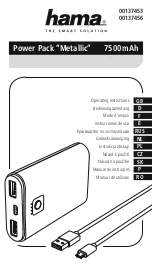
English–5
2 609 932 333 • 29.9.04
Position the holder for the guide roller
18
in such a
manner that the guide roller
9
faces against the back of
the saw blade. Precise cuts are possible only when the
guide roller faces tightly against the back of the saw
blade.
Tighten the screw
17
again.
Sawing with the base plate
6
offset is possible only
with a mitre angle of 0°. In addition, the parallel guide
with circle cutter
21
(accessory) as well as the splinter
guard
16
may not be used.
Sawdust Blower Device
With the air jet of the sawdust blower device
7
, the cut-
ting line can be kept free of dust and chips.
Switching on the sawdust blower
device:
For cuts in materials with high
removal rate, such as in wood, plas-
tic, etc., turn the switch
7
in clock-
wise direction to the “Blowing”
position.
Switching off the sawdust blower
device:
For cuts in metal and when using
coolant/lubricant, turn the switch
7
in anticlockwise direction to the “0”
position.
Starting Operation
Observe correct mains voltage!
The voltage of the
power source must agree with the voltage specified on
the nameplate of the machine. Power tools marked with
230 V can also be operated with 220 V.
Switching On and Off
To
start
the machine, press the On/Off switch
2
.
To
lock
the On/Off switch
2
, keep it depressed and
push the lock-on button
1
to the right or left.
To
switch off
the machine, release the On/Off switch
2
. When the On/Off switch
2
is locked, press it first and
then release it.
PST 680 E: After longer periods of work at low stroke
rate, the machine can heat up considerably. Remove
the saw blade from the machine and allow the machine
to cool down by running it for approx. 3 minutes at max-
imum stroke rate.
Controling the Stroke Rate (PST 680 E)
Increasing or reducing the pressure on the On/Off
switch
2
enables stepless stroke-rate control of the
switched-on machine.
The required stroke rate is dependent on the material
and the working conditions and can be determined by
a practical trial.
Reducing the stroke rate is recommended when the
saw blade engages in the material as well as when
sawing plastic and aluminium.
When the On/Off switch
2
is locked, it is not possible
to reduce the stroke rate.
Operating Instructions
When working small or thin work pieces, always
use a sturdy support or a saw table (accessory).
Saw Blade Storage (see figure E)
Four saw blades with lengths of up to 110 mm can be
stored in the saw blade storage
5
. Place the saw
blades with the T-shank into the intended recess of the
saw blade storage. Two saw blades can be placed on
top of each other.
Shut the saw blade storage and slide it to the stop into
the opening of the base plate
6
.
Plunge Cutting (see figure F)
Plunge cuts may only be applied to soft materi-
als, such as wood, gypsum plaster boards, etc.!
Use only short saw blades for plunge cutting. Plunge
cutting is possible only with the mitre angle set at 0°.
Place the machine with the front edge of the base plate
6
on to the workpiece and switch on. For machines with
stroke rate control, select the maximum stroke rate.
Firmly hold the machine against the workpiece and by
tilting the machine, slowly plunge the saw blade into the
workpiece.
When the base plate
6
fully lays on the workpiece, con-
tinue sawing along the desired cutting line.
Parallel Guide with Circle Cutter (Accessory)
For cuts using the parallel guide with circle cutter
21
(accessory), the thickness of the material must not
exceed a maximum of 30 mm.
Parallel Cuts (see figure G): Loosen the locking screw
20
and slide the scale of the parallel guide through the
lead
19
in the base plate. Set the desired cutting width
as the scale value on the inside edge of the base plate.
Tighten the locking screw
20
.
Circular Cuts (see figure H): Set the locking screw
20
to the other side of the parallel guide. Slide the scale of
the parallel guide through the lead
19
in the base plate.
Drill a hole in the workpiece centred in the section to be
sawn. Insert the centring tip
22
through the inside
opening of the parallel guide and into the drilled hole.
Set the radius as the scale value on the inside edge of
the base plate. Tighten the locking screw
20
.
Coolant/Lubricant
When sawing metal, coolant/lubricant should be
applied alongside cutting line because of the material
heating up.
OBJ_BUCH-2 609 932 333-002.book Seite 5 Mittwoch, 29. September 2004 10:23 10
















































